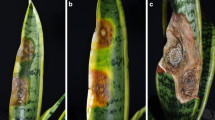Abstract
A new disease was found in Japan, on celery (Apium graveolens var. dulce) having severe chlorotic leaf spot, stunt, and dwarf with leaf curl. A spore suspension from the fungus isolated from affected plants induced identical symptoms 14 days after plants were sprayed. Identification and molecular characterization showed that the causal agent is Colletotrichum simmondsii. This report is the first of stunt anthracnose on celery caused by C. simmondsii. We propose the name “stunt anthracnose” for the new disease. Colletotrichum acutatum sensu lato, as reference pathogen of celery anthracnose, should be changed to C. fioriniae based on morphological and molecular characteristics.



Similar content being viewed by others
References
Anonymous (2000) Common names of plant diseases in Japan. Japan Plant Protection Association, Tokyo
Felsenstein J (1985) Confidence limits on phylogenies: an approach using the bootstrap. Evolution 39:783–791
Glass NL, Donaldson GC (1995) Development of primer sets designed for use with the PCR to amplify conserved genes from filamentous ascomycetes. Appl Environ Microbiol 61:1323–1330
Guerber JC, Liu B, Correll JC, Johnston PR (2003) Characterization of diversity in Colletotrichum acutatum sensu lato by sequence analysis of two gene introns, mtDNA and intron RFLPs, and mating compatibility. Mycologia 95:872–895
Heaton JB, Dullahide SR (1993) Control of celery leaf curl disease caused by Colletotrichum acutatum. Australas Plant Pathol 22:152–155
Kimura M (1980) A simple method for estimating evolutionary rates of base substitutions through comparative studies of nucleotide sequences. J Mol Evol 16:111–120
Larkin MA, Blackshields G, Brown NP, Chenna R, McGettigan PA, McWilliam H, Valentin F, Wallace IM, Wilm A, Lopez R, Thompson JD, Gibson TJ, Higgins DG (2007) Clustal W and Clustal X version 2.0. Bioinformatics 23:2947–2948
O’Donnell K, Cigelnik E (1997) Two divergent intragenomic rDNA ITS2 types within a monophyletic lineage of the fungus Fusarium are nonorthologous. Mol Phylogenet Evol 7:103–116
Ogiso H, Fujinaga M, Saito H, Takehara T, Yamanaka S (2002) Physiological races and vegetative compatibility groups of Fusarium oxysporum f. sp. lactucae isolated from crisphead lettuce in Japan. J Gen Plant Pathol 68:292–299
Saitou N, Nei M (1987) The neighbor-joining method: a new method for reconstructing phylogenetic trees. Mol Biol Evol 4:406–425
Shivas RG, Tan YP (2009) A taxonomic re-assessment of Colletotrichum acutatum, introducing C. fioriniae comb. et stat. nov. and C. simmondsii sp. nov. Fungal Divers 39:111–122
Sreenivasaprasad S, Talhinhas P (2005) Genotypic and phenotypic diversity in Colletotrichum acutatum, a cosmopolitan pathogen causing anthracnose on a wide range of hosts. Mol Plant Pathol 6:361–378
Sutton BC (1980) Colletotrichum. In: Sutton BC (ed) The coelomycetes: fungi imperfecti with pycnidia, acervuli and stromata. Commonwealth Mycological Institute, Kew, pp 522–537
Sutton BC (1992) The genus Glomerella and its anamorph Colletotrichum. In: Bailey JA, Jeger MJ (eds) Colletotrichum: biology, pathology and control. CAB International, Wallingford, pp 1–26
Swofford DL (2002) PAUP*: PHYLOGENETIC analysis using parsimony (*and other methods), ver. 4.0 beta. Sinauer, Sunderland
Takeuchi J, Horie H, Kubota M (2000) First occurrence of anthracnose of Apium graveolens by Colletotrichum acutatum and aspergillus blight of Ruscus hypoglossum by Aspergillus niger in Japan (abstract in Japanese). Jpn J Phytopathol 66:92
Talhinhas P, Sreenivasaprasad S, Neves-Martins J, Oliveira H (2005) Molecular and phenotypic analyses reveal association of diverse Colletotrichum acutatum groups and a low level of C. gloeosporioides with olive anthracnose. Appl Environ Microbiol 71:2987–2998
Thompson JD, Gibson TJ, Plewniak F, Jeanmougin F, Higgins DG (1997) The Clustal X windows interface: flexible strategies for multiple sequence alignment aided by quality analysis tools. Nucleic Acids Res 25:4876–4882
Vinnere O, Fatehi J, Wright SAI, Gerhardson B (2002) The causal agent of anthracnose of Rhododendron in Sweden and Latvia. Mycol Res 106:60–69
White TJ, Bruns T, Lee S, Taylor J (1990) Amplification and direct sequencing of fungal ribosomal RNA genes for phylogenetics. In: Innis MA, Gelfand DH, Sninsky JJ, White TJ (eds) PCR protocols: a guide to methods and applications. Academic Press, San Diego, pp 315–322
Acknowledgments
We thank Dr. T. Kanto of the Hyogo Prefectural Technology Center for Agriculture, Forestry and Fisheries for technical advice.
Author information
Authors and Affiliations
Corresponding author
Additional information
The nucleotide sequence data reported here are available in the DDBJ/EMBL/GenBank databases under accession numbers AB618089, AB618090, AB618091 and AB618092, and the fungal isolates examined were deposited in NIAS Genebank as MAFF242590 and MAFF242591.
Rights and permissions
About this article
Cite this article
Fujinaga, M., Yamagishi, N., Ogiso, H. et al. First report of celery stunt anthracnose caused by Colletotrichum simmondsii in Japan. J Gen Plant Pathol 77, 243–247 (2011). https://doi.org/10.1007/s10327-011-0319-9
Received:
Accepted:
Published:
Issue Date:
DOI: https://doi.org/10.1007/s10327-011-0319-9




